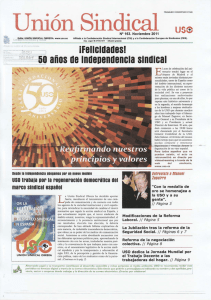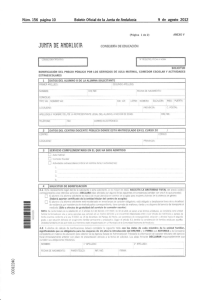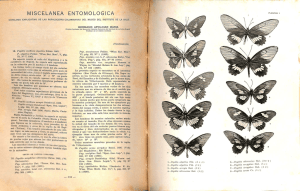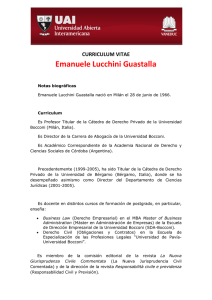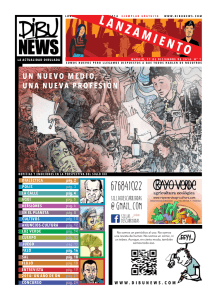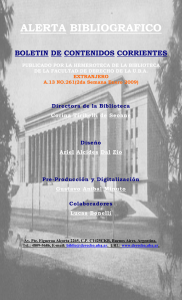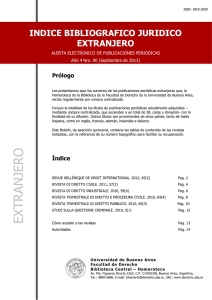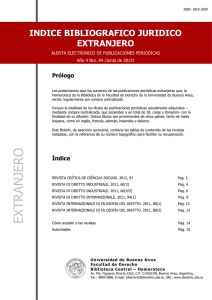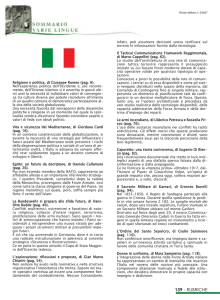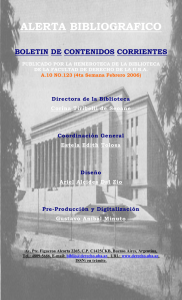alerta bibliografico - Facultad de Derecho
Anuncio
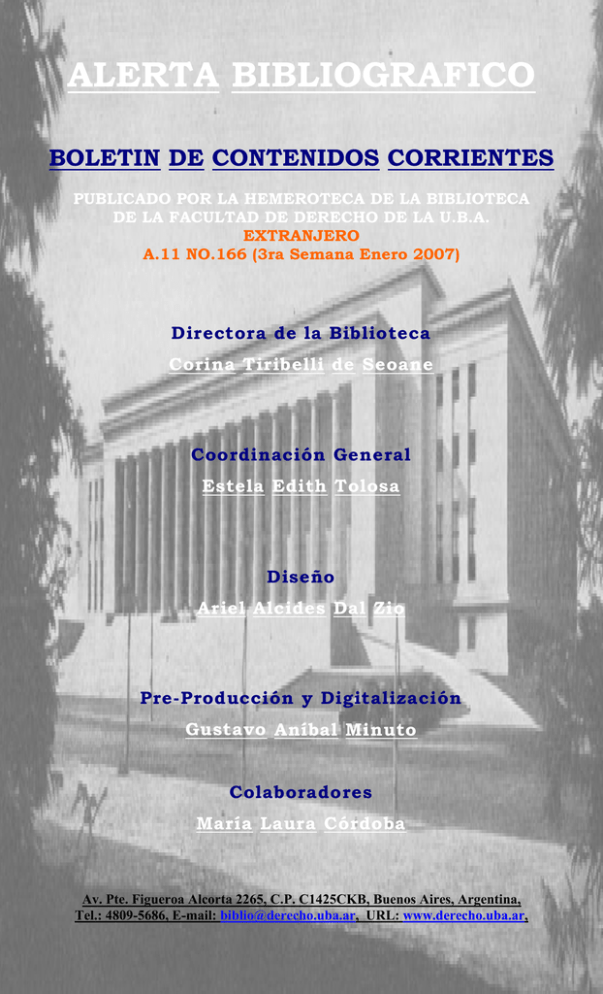
ALERTA BIBLIOGRAFICO BOLETIN DE CONTENIDOS CORRIENTES PUBLICADO POR LA HEMEROTECA DE LA BIBLIOTECA DE LA FACULTAD DE DERECHO DE LA U.B.A. EXTRANJERO A.11 NO.166 (3ra Semana Enero 2007) Directora de la Biblioteca Corina Tiribelli de Seoane Coordinación General Estela Edith Tolosa Diseño Ariel Alcides Dal Zio Pre-Producción y Digitalización Gustavo Aníbal Minuto Colaboradores María Laura Córdoba Av. Pte. Figueroa Alcorta 2265, C.P. C1425CKB, Buenos Aires, Argentina, Tel.: 4809-5686, E-mail: [email protected], URL: www.derecho.uba.ar, FACULTAD DE DERECHO AUTORIDADES Decano Atilio Aníbal Alterini Vicedecano Tulio Ortiz Secretario Académico Germán Gonzalo Alvarez Sub-secretario Académico Sergio Brodsky Secretario de Hacienda y Administración General Alejandro Gómez Sub-secretario de Hacienda y Administración General Luis Mateo Barreiro Secretaria de Investigación y Relaciones Institucionales Eduardo Barbarosch Secretario de Extensión Universitaria Juan Pablo Mas Vélez Comisión de Biblioteca Consejo Directivo Dr. Alberto Bueres Dr. Alberto Dalla Via Dr. Daniel Sabsay Dr. Jorge del Azar Dr. Juan Curuchet Paula Streger Celia Loperena PROLOGO A LOS USUARIOS: Les presentamos aquí los sumarios de las publicaciones periódicas extranjeras que, la Biblioteca de la Facultad de Derecho de la Universidad de Buenos Aires, recibe regularmente por compra desde 1993. Se trata de 86 títulos de la disciplina y ciencias relacionadas en diferentes idiomas: inglés, castellano, francés, italiano, alemán, que se irán presentando de acuerdo a su frecuencia de aparición en varias entregas. Dichos títulos se encuentran para su consulta exclusivamente en la Hemeroteca (1er. piso) de la Facultad de Derecho. ACCESO A LAS REVISTAS: Para su consulta solicitamos: 1) tomar nota del título, del año, volumen y fascículo, 2) tomar nota de la ubicación física (código alfanumérico a la izquierda de los sumarios) 3) solicitarlo personalmente en la Hemeroteca. La consulta y localización de los de artículos puede adelantarlo por e-mail, correo o fax. La obtención del documento se consigue concurriendo personalmente, y la copia de algún artículo es con cargo por cuenta de cada usuario. HORARIO DE ATENCION: Lunes a Viernes: 10 a 20 Hs Para más información, solicitamos dirigirse a la Hemeroteca: 4809-5686 (Sala) / 4809-5634 (Fax) [email protected] SU OPINION COMO DOCENTE NOS INTERESA A todos aquellos que deseen colaborar con la selección de publicaciones periódicas para la Hemeroteca de la Facultad, les solicitamos la amabilidad de enviarnos el formulario que se adjunta (personalmente, vía fax y/o correo electrónico, correo postal) con sus valiosas sugerencias, las que serán tenidas en cuenta para la evaluación anual en vistas a la incorporación de dichos títulos como suscripciones cada año lectivo. EL INCREMENTO DE LA COLECCION ESPECIALIZADA DE LA BIBLIOTECA DEPENDE EN GRAN MEDIDA DE SU GENEROSA Y SIEMPRE ACERTADA COLABORACION. LA COMUNICACION CONSTANTE CON LA BIBLIOTECA NOS DARA A NOSOTROS UNA IDEA MAS PRECISA DE SUS NECESIDADES Y PODREMOS BRINDARLES MEJORES SERVICIOS Y MAS ACERTADOS. DESDE YA AGRADECEMOS LA ATENCION CUESTIONARIO Referencia: Selección y adquisición de Publicaciones Periódicas. 1) Cátedra:........................................................................................................... 2) Materia:............................................................................................................ 3) Profesor Titular:.............................................................................................. 4) Profesor adjunto:.............................................................................................. Títulos Propuestos. 1) ¿Qué títulos argentinos debería poseer la Hemeroteca de la Facultad? (en lo posible consignar el editor y su dirección) ................................................................................................................................. ................................................................................................................................. ................................................................................................................................. ................................................................................................................................. ................................................................................................................................. ................................................................................................................................. ................................................................................................................................. ................................................................................................................................. .................................................................................................................................. ................................................................................................................................. 2) ¿Qué títulos extranjeros debería poseer la Hemeroteca de la Facultad?(en lo posible consignar el editor y su dirección) ................................................................................................................................. ................................................................................................................................. ................................................................................................................................. ................................................................................................................................. ................................................................................................................................. ................................................................................................................................. ................................................................................................................................. ................................................................................................................................. ................................................................................................................................. .................................................................................................................................. 3) ¿Conoce la existencia de la colección de Publicaciones Periódicas (Hemeroteca) de la Biblioteca? SI .......... NO .......... Este formulario guía puede ser ampliado por Ud. en hoja aparte y/o copiado tantas veces como sea necesario, con cualquier otra sugerencia bibliográfica. Favor de remitirlo a la Dirección de Biblioteca, por cualquiera de los medios antes mencionados. Nº 1 TITULO RECUEIL DES COURS: COLLECTED COURSES OF THE HAGUE ACADEMY OF INTERNATIONAL LAW Año, Vol.(nº) 2004, 309 2 REVUE FRANÇAISE DE SCIENCE POLITIQUE 3 RIVISTA INTERNAZIONALE DI FILOSOFIA DEL DIRITTO 2006, 56(6) 2006, 83(3) 4 RIVISTA TRIMESTRALE DI DIRITTO PUBBLICO 2006, 56(3) 05:341 R245c RECUEIL DES COURS C CO OLLLLEEC CTTEED DC CO OU UR RSSEESS O OFF TTH HEE H HA AG GU UEE A AC CA AD DEEM MY YO OFF IIN NTTEER RN NA ATTIIO ON NA ALL LLA AW W 2004 N º 309 TABLE DES MATIÈRES Introduction . Pág. 21 Chapitre I. L’organisation du mouvement sportif international et national . Pág. 28 Section I. Une organisation pyramidale . Pág. 28 Par. 1. Les organismes sportifs fédérateurs internationaux et nationaux . Pág. 28 A. Identification des principaux organismes sportifs fédérateurs internationaux et nationaux . Pág. 29 1) Le Comité international olympique . Pág. 29 2) Les fédérations sportives internationales . Pág. 35 3) Les comités nationaux olympiques (CNO) . Pág. 37 4) Les fédérations sportives nationales . Pág. 40 B. Articulation entre les principaux organismes sportifs fédérateurs internationaux et nationaux . Pág. 42 Par. 2. Les groupements sportifs et les licenciés . Pág. 44 Section II. Une organisation déconcentrée . Pág. 48 Par. 1. Les déconcentrations locales . Pág. 48 Par. 2. Les déconcentrations nationales: les ligues professionnelles Pág. 50 Chapitre II. Les règles du mouvement sportif international et national Pág. 54 Section I. Les règles applicables aux activités sportives en général. Pág. 55 Par. 1. Reconnaissance des règles applicables aux activités sportives en général . Pág. 55 A. Les règles élaborées par le mouvement sportif . Pág. 55 B. Les règles élaborées par les Etats . Pág. 62 1) Les règles spécifiques aux activités sportives . Pág. 63 2) Les règles communes appliquées aux activités sportives . Pág. 64 Par. 2. Interférences entre les règles applicables aux activités sportives en général . Pág. 66 A. Les « concessions » de la règle d'Etat à la « règle du sport » . Pág. 68 B. Le renvoi de la « règle du sport » à la règle d'Etat . Pág. 71 Section II. Les règles applicables en particulier aux activités sportives professionnelles (quelques exemples) . Pág. 72 Par. 1. Les règles relatives à l'organisation . Pág. 72 A. Les règles d'organisation directement dictées par une volonté de préserver l'équilibre et l'équité des compétitions . Pág. 73 B. Les règles d'organisation indirectement dictées par la volonté de préserver l'équilibre et l'équité des compétitions . Pág. 78 Par. 2. Les règles relatives aux relations contractuelles . Pág. 79 A. Les relations contractuelles de travail clubs sportifs -sportifs . Pág. 80 B. Les relations contractuelles clubs-sportifs, sportifs-intermédiaires sportifs . Pág. 83 Chapitre III. Les litiges relatifs aux activités sportives . Pág. 86 Section 1. La diversité des « litiges sportifs » . Pág. 86 Par. 1. La nature des «litiges sportifs» . Pág. 86 Par. 2. Les plaideurs aux «litiges sportifs» . Pág. 93 Section II. Le règlement des «litiges sportifs» . Pág. 94 Par. 1. Le règlement des «litiges sportifs» au sein du mouvement sportif . Pág. .95 A. Le règlement des «litiges sportifs» par des instances internes au mouvement sportif . Pág. 95 1) Le règlement traditionnel des « litiges sportifs » . Pág. 95 a) Les différents organes de règlement des litiges . Pág. 96 b) La normalisation des organes de règlement des litiges. Pág. 100 2) Le règlement original des « litiges sportifs » . Pág. 101 a) Le règlement original des « litiges sportifs » imposé par le législateur . Pág. 101 b) Le règlement original des « litiges sportifs » à l'initiative d'un juge d’Etat . Pág. 105 c) Le règlement original des « litiges sportifs » favorisé par des organismes sportifs nationaux . Pág. 106 B. Le règlement des « litiges sportifs » par des instances créées sur initiative du mouvement sportif: le modèle international, le Tribunal arbitral du sport . Pág. 107 1) L’organisation du Tribunal arbitral du sport (TAS) . Pág. 108 2) L’élaboration de règles internationales spécifiques à l'organisation et/ou à la pratique des activités sportives . Pág. 110 Par. 2. Le règlement des « litiges sportifs » par les juridictions d'Etat Pág. 116 A. L'intervention du juge d’Etat Pág. 117 B. Les limites à l'intervention du juge d’Etat . Pág. 118 Conclusion . Pág. 119 General introduction Pág. 139 Part 1. The place of bilateral agreements in EC law . Pág. 149 Chapter I. Introduction . Pág. 149 Chapter II. The EC's legal personality . Pág. 150 Chapter III. The legal basis for the conclusion of bilateral agreements Pág. 154 A. Nature and role . Pág. 154 B. EC Treaty provisions providing a substantive legal basis . Pág. 158 (a) Common commercial policy: Article 133 EC . Pág. 158 1. Structure of Article 133 EC . Pág. 159 2. Article 133 EC as a single legal basis . Pág. 163 2.1. Bilateral agreements of a general nature . Pág. 164 2.2. Bilateral sectoral agreements . Pág. 166 3. Article 133 EC in combination with other substantive EC Treaty provisions as legal bases . Pág. 168 (b) Association agreements . Pág. 168 (c) Substantive EC Treaty provisions other than on commercial policy as legal bases . Pág. 169 1. The relevant substantive EC Treaty provisions . Pág. 169 2. One single substantive EC Treaty provision as a legal basis Pág. 172 3. More than one substantive EC Treaty provision as legal bases . Pág. 173 3.1. Bilateral development co-operation agreements: Articles 113 and 181 EC . Pág. 174 3.2. Multiple substantive EC Treaty provisions . Pág. 182 4. Article 308 EC as a legal basis . Pág. 185 4.1. Potential and limits . Pág. 185 4.2. Bilateral agreements of a general nature . Pág. 188 4.3. Bilateral sectoral a reements . Pág. 192 C. Implied powers . Pág. 192 (a) Potential and limits . Pág. 192 (b) An abundant practice . Pág. 195 Chapter IV. Shared competence and mixed bilateral agreements . Pág. 203 A. Shared competence . Pág. 204 B. Mixed bilateral agreements . Pág. 207 Chapter V. From negotiation to conclusion of bilateral agreements Pág. 212 A. Negotiations . Pág. 214 B. Signature and conclusion . Pág. 216 C. Role of the European Parliament . Pág. 223 Chapter VI. Fulfilment of obligations, revision and termination of bilateral agreements . Pág. 231 A. Fulfilment of obligations . Pág. 231 B. Revision and termination . Pág. 234 Chapter VII. Bilateral agreements and judicial review . Pág. 236 A. Compatibility of an envisaged agreement with the EC Treaty . .Pág. 238 B. Review of legality . Pág. 241 Chapter VIII. Direct effect of bilateral agreements . Pág. 246 A. The lack of direct effect of GATT/WTO . Pág. 249 (a) The principle established for GATT . Pág. 249 (b) Limited scope for nuances to the principle . Pág. 251 (c) The principle reconfirmed for WTO . Pág. 255 B. Possible direct effect of bilateral agreements: conditions and scope Pág. 262 (a) The first judgments: the basics . Pág. 262 (b) Specific bilateral agreements and direct effect . Pág. 267 1 . The EC-Turkey bilateral instruments . Pág. 268 1.1. The 1963 Association Agreement and 1970 Additional Protocol with Turkey . Pág. 268 1.2. Decisions of the EC-Turkey Association Council . Pág. 272 1.2.1. Decision 1/80 . Pág. 273 1.2.2. Decision 3/80 . Pág. 276 2. Co-operation Agreements with Maghreb countries . Pág. 280 3. Europe Agreements with the CEECs and Partnership and Co-operation Agreements with the Newly Independent States . Pág. 286 C. Evaluation . Pág. 293 Chapter IX. Articles 24 and 38 EU: conclusion of bilateral agreements by the EU . Pág. 298 A. Rules and procedure . Pág. 298 B. Implementation . Pág. 299 Chapter X. Accession treaties . Pág. 305 A. Accession treaties are not bilateral agreements of the EC . Pág. 306 B. The effect of EU enlargement on bilateral agreements already concluded by the EC . Pág. 307 Part II. Bilateral association agreements and Partnership and Cooperation Agreements: substantive analysis Pág. 311 Chapter I. Introduction . Pág. 311 Chapter II. Bilateral association agreements . Pág. 314 A. Bilateral association agreements as pre-accession instruments . Pág. 320 (a) The first bilateral association agreements . Pág. 321 1. The Association Agreement with Greece . Pág. 321 2. The Association Agreement with Turkey . Pág. 325 3. Association Agreements with Cyprus and Malta . Pág. 339 (b) Europe Agreements with countries of Central and Eastern Europe . Pág.343 1. Background . Pág. 343 2. Scope, objectives and contents . Pág. 347 3. Europe Agreements as pre-accession instruments Pág. 354 (c) Stabilization and Association Agreements with countries of South East Europe . Pág. 356 1. Background . Pág. 356 1. 1. The Co-operation Agreement with Yugoslavia . Pág. 356 1.2. The Europe Agreement with Slovenia . Pág. 359 1.3. EU-Croatia bilateral relations after the independence of Croatia . Pág. 360 1.4. The Co-operation Agreement with the Former Yugoslav Republic of Macedonia . Pág. 361 1.5. EU-Bosnia and Herzegovina and EU-Serbia and Montenegro bilateral relations .Pág. 364 1.6. The Trade and Co-operation Agreement with Albania Pág. 364 2. The conclusion of Stabilization and Association Agreements Pág. 365 2.1. The regional approach . Pág. 368 2.2. Scope, objectives and contents . Pág. 373 B. Bilateral association agreements with no accession perspective . Pág. 377 (a) Euro-Mediterranean Association Agreements . .Pág. 378 1. Background . Pág. 378 2. A network of bilateral Euro-Mediterranean Partnership Agreements . Pág. 382 2.1. Scope, objectives and contents . Pág. 386 2.2. Specific effects of the Israeli-Palestinian conflict . Pág. 393 2.2.1. The 1995 Agreement with Israel . Pág. 393 2.2.2. The Agreement with the PLO . Pág. 400 3. New Neighbourhood Policy and Euro-Mediterranean Association Agreements . Pág. 405 (b) The Association Agreement with Chile . Pág. 407 C. Article 310 EC as a legal basis for agreements which are not “association agreements” ? . Pág. 410 (a) The 1999 Sectoral Agreements with Switzerland: the Bilaterals I . Pág. 412 1. Background and conclusion . Pág. 412 2. Follow-up: the Bilaterals II . Pág. 415 (b) The Trade, Development and Co-operation Agreement with South Africa . Pág. 421 III. Partnership and Co-operation Agreements with the Newly ependent States . Pág. 423 A. Background . Pág. 423 B. Scope, objectives and contents . Pág. 426 C. PCAs with Russia and the Western NIS . Pág. 429 a) Russia . Pág. 430 b)Ukraine . Pág. 438 c)Moldova . Pág. 443 d)Belarus . Pág. 445 D. PCAs with the countries from the Caucasus and Central Asia Pág. 448 05:32 R328f4 REVUE FRANÇAISE DE SCIENCE POLITIQUE http://www.afsp.msh-paris.fr/publi/rfsp/rfsp.html 2006 Vol. 56 Nº 6 SOMMAIRE ARTICLES La production notabiliaire du militantisme au Parti socialiste. Philippe Juhem Pág. 909 Au-delà du déclin : difficultés, rationalisation et réinvention du recours à la grève dans les stratégies confédérales des syndicats. Baptiste Giraud. Pág. 943 Tocqueville face au thème de la « nouvelle aristocratie ». La difficile naissance des partis en France. Lucien Jaume Pág. 969 Le Parlement face à ses adversaires. La réplique allemande au désenchantement démocratique dans l'entre deux-guerres. Sandrine Baume. Pág. 985 Les défis de l'européanisation dans la réforme du système judiciaire roumain post-communiste. Entre inertie et transformation. Ramona Coman. Pág. 999 LECTURES CRITIQUES L'épistémologie du politique selon Pierre Favre. Jacques Lagroye. Pág. 1029 L’influence des facteurs institutionnels sur la délibération comme action politique. Bernard Reber Pág. 1040 COMPTES RENDUS Jacques E. C. Hymans, The Psychology of Nuclear Proliferation, Identity, Emotions and Foreign Policy. Alexandre Hummel. Pág. 1045 Antoine Vauchez, L'institution judiciaire remotivée. Le processus d'institutionnalisation d'une « nouvelle justice » en Italie (1960-2000). Eric Farges. Pág. 1048 Jean-Jacques Pardini, Claude Deves (dit.), La réforme de l'État. Julien Barroche. Pág. 1051 REVUES DES REVUES Pág. 1053 INFORMATIONS BIBLIOGRAPHIQUES Pág. 1055 05:340.12 R526i RIVISTA INTERNAZIONALE DI FILOSOFIA DEL DIRITTO 2006 Vol. 83 Nº 3 SOMMARIO STUDI MARIO G. LOSANO, Tokyo 1889: il corso di filosofia del diritto del consigliere giuridico Alessandro Paternostro Pág. 341 ENRICO FERRI, Antimo Negri lettore di Stirner Pág. 373 FERNANDO H. LLANO ALONSO, Las glosas de José Ortega y Gasset a Hans Kelsen Pág. 407 GUIDO SARACENI, Il Profeta e la legge Pág. 435 IN MEMORIAM Ernesto Molinari (1933-2005), Amedeo G. Conte Pág. 461 Miguel Reale (1910-2006), Mario G. Losano Pág. 465 Enzo Sciacca (1934-2006), Francesco Riccobono Pág. 477 SPORE al-Malik al-Afdal, Modi deontici, 1370, a cura di Amedeo G. Conte Pág. 481 NOTE E DISCUSSIONI Michel Villey e la filosofia del diritto: una lettura di Les Carnets, Bjarne Melkevik Pág. 487 Stato, bene comune e autorità della Chiesa in Carlo Francesco D'Agostino, Gabriele De Anna Pág. 515 Un convegno italo-polacco sulle regole costitutive, Alessandro Olivari Pág. 527 SCHEDARIO Ballesteros J., Repensar la paz. Krippendorff E., Shakespeare politico. Milli M., Nietzsche e il messaggio politico di Zarathustra. Schmitt C., Risposte a Norimberga. Zolo D., Globalizzazione Pág. 529 05:342(45) R526dp RIVISTA TRIMESTRALE DI DIRITTO PUBBLICO 2006 Vol. 56 Nº 3 SOMMARIO Articoli GAETANO SILVESTRI, La nascita della Costituzione italiana ed i suoi valori fondamentali Pág. 585 SABINO CASSESE, Il sorriso del gatto, ovvero dei metodi nello studio del diritto pubblico Pág. 597 FRANCESCO FONDERICO, La 'codificazione' del diritto dell'ambiente in Italia: modelli e questioni Pág. 613 MARCO MACCHIA, La compliance al diritto amministrativo globale: il sistema di controllo della convenzione di Aarhus Pág. 639 Note STEFANO BATTINI, Gli uffici di staff dei ministri: diversi mauguali? Pág. 671 BENEDETTO CIMINO, Gli uffici di diretta collaborazione nella Presidenza del Consiglio dei ministri Pág. 677 DARIO BEVILACQUA - CARLO NOTARMUZI, Gli uffici di diretta collaborazione del Ministro dell'interno Pág. 711 LUIGI FIORENTINO - VALENTINA MILANI, Gli uffici di diretta collaborazione del Ministro dell'economia e delle finanze Pág. 727 CHIARA MARTINI, Gli uffici di diretta collaborazione del Ministro dell'istruzione, dell'università e della ricerca Pág. 749 Rassegne MATTEO GNES - EDOARDO CHI'TI, Cronache comunitarie 2005 . Pág. 767 CLAUDIA GOLINO, Enti non profit, attività di impresa e concorrenza Pág. 799 Rivista bibliografica Opere di Matteo Gnes (Daria De Pretis); Giuseppe Dì Genio (Tania Groppi); Mauro Tebaldi (Roberta Calvano); Andrea Maltoni (Nicola Bassi); Stefania Vasta (Mariastefania De Rosa); Agostino Meale (Michele Giovannini); Sergio Perongini (Valeria Mazzarelli); Francesco De Leonardis (Manuela Veronelli) Pág. 843 Note bibliografiche a cura di Bruno Carotti, Sabino Cassese, Cristina Cicogna, Angela Ferrari Zumbini, Claudio Franchini, Bernardo Giorgio Mattarella Pág. 876 Notizie Il secondo Global Administrative Law Seminar (Benedetto Cimino) Pág. 883 Un seminario sulla contabilità degli enti pubblici (R.P.) Pág. 885 Un seminario sul rapporto autorità-libertà nell'Unione europea (Giovanna Di Maria) Pág. 893 Un rapporto sulla programmazione strategica e sui controlli interni nei ministeri (Dario Bevilacqua) Pág. 895 La relazione annuale dell'Ispettorato generale di finanza (Elisabetta Morlino) Pág. 896 L'Association française pour la recherche en droit administratif (Lorenzo Casini) Pág. 898 Libri ricevuti Pág. 899 Notizie sui collaboratori Pág. 903 Istruzioni per gli autori Pág. 907
